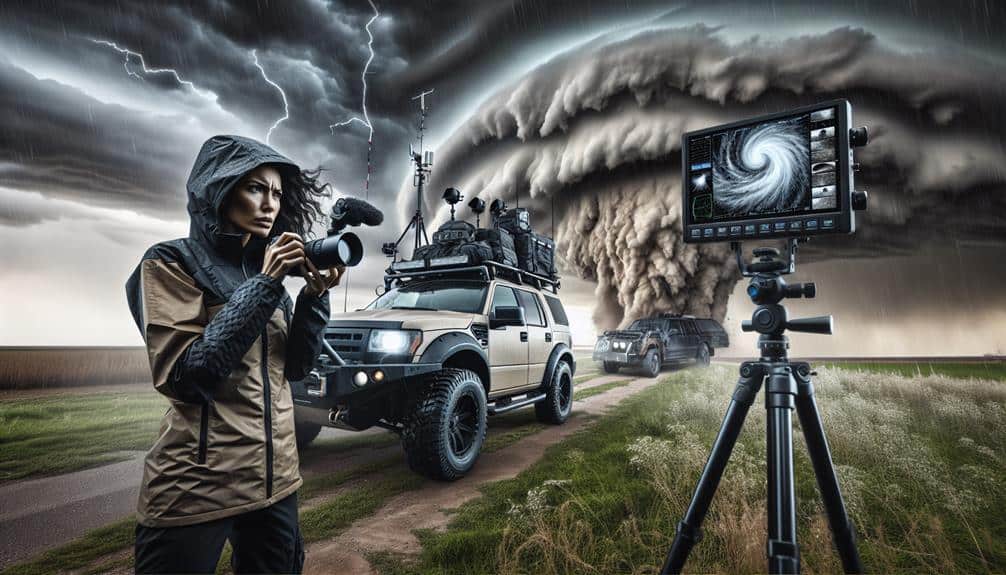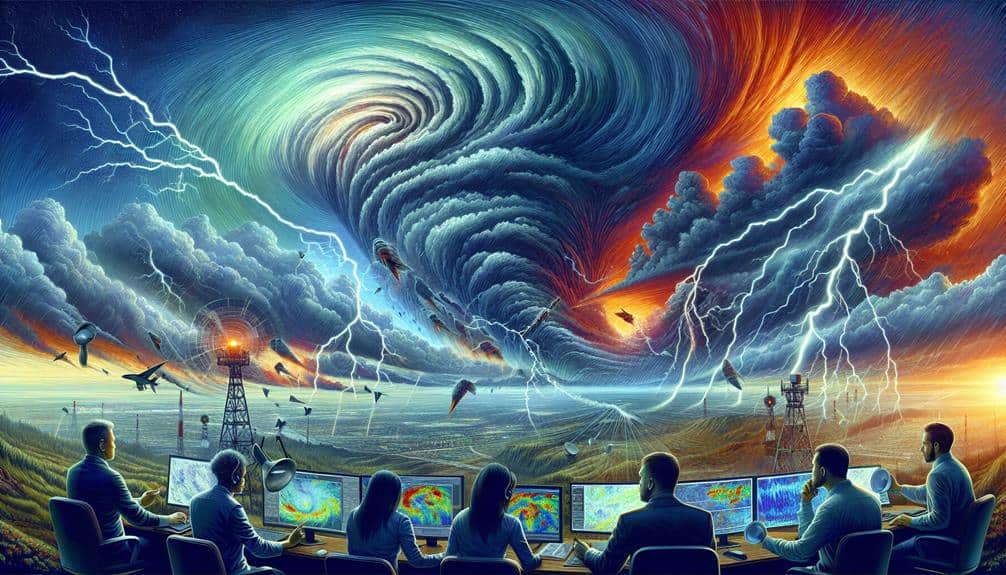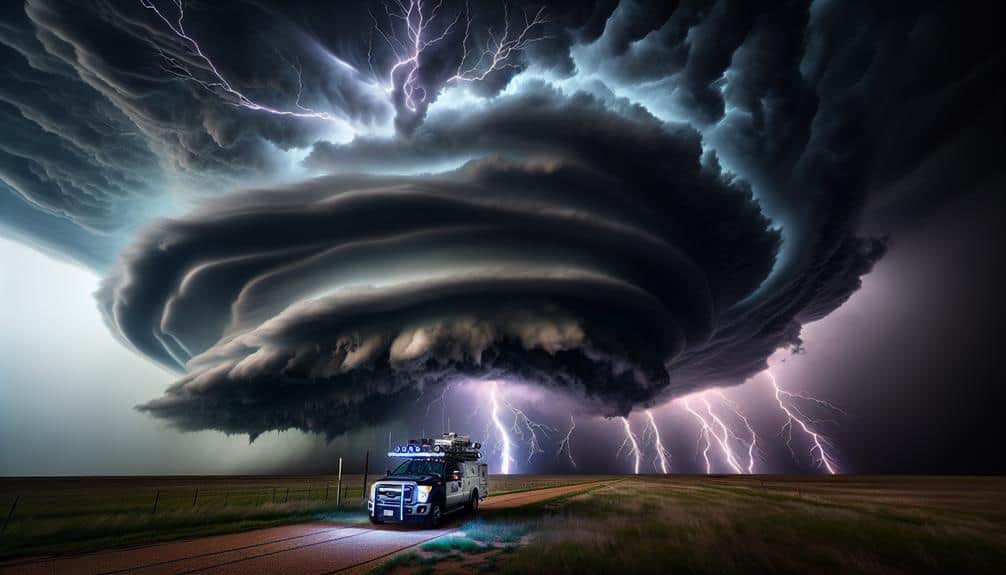When chasing supercell storms, we must follow rigorous ethical guidelines to guarantee safety and integrity. We rely on accurate meteorological data and expert advice, prioritize public and team safety, and respect private property by seeking permission and minimizing environmental impact. We coordinate with local authorities for real-time reporting and share data responsibly, adhering to established safety protocols. Our ethical conduct extends to educating the public with scientifically accurate information and maintaining clear communication channels. This approach not only enhances safety but also contributes to the broader understanding of these powerful natural phenomena. There's much more to uncover on responsible storm chasing.
Key Points
- Adhere to meteorological data and expert guidelines for accurate and safe storm chasing.
- Respect private property by obtaining landowner permission and avoiding damage to structures and crops.
- Maintain clear and consistent communication with team members and local authorities.
- Prioritize safety for yourself, your team, and the public during storm chasing activities.
Prioritizing Safety
When chasing supercell storms, we must prioritize safety by strictly adhering to meteorological data and expert guidelines. Understanding weather patterns is important. It allows us to predict storm paths accurately, reducing the inherent risks. We analyze radar data, satellite imagery, and storm reports to determine the storm's intensity and trajectory. By doing this, we can formulate effective safety measures.
Risk assessment is another critical component. We evaluate potential hazards, such as lightning, hail, and tornadoes, to decide if the chase is feasible. We use real-time data to constantly update our risk models. This dynamic approach ensures our decisions are informed and responsive to changing conditions.
Emergency response plans are necessary. We establish clear communication channels, designate safe zones, and prepare for rapid evacuation if necessary. Each team member should be trained in first aid and equipped with emergency kits. By having these protocols in place, we can act swiftly and efficiently, minimizing harm.
Our commitment to safety isn't a restriction but a pathway to freedom. By respecting the power of nature and preparing meticulously, we ensure our storm-chasing adventures are thrilling and safe.
Respecting Private Property
When chasing supercell storms, we must strictly comply with posted 'No Trespassing' signs to respect private property. Securing prior permission from landowners guarantees we're not infringing on their rights.
Additionally, following the 'Leave No Trace' principle minimizes our impact on the environment and maintains goodwill with the community.
No Trespassing Signs
Why is it important that we respect no entry signs while pursuing supercell storms?
First, adhering to these signs ensures we're not violating property rights, which could lead to serious legal implications. Trespassing can result in fines, legal action, and even arrest, all of which can severely hinder our storm photography endeavors.
Furthermore, respecting private property maintains a positive relationship between storm chasers and landowners, which is essential for gaining future permissions and access.
From a scientific perspective, storm chasers play a significant role in data collection and analysis. However, we must balance our mission with ethical conduct. Ignoring no entry signs can lead to potential conflicts that distract from our primary objective: studying and documenting storm phenomena.
Data shows that cooperation with landowners often leads to better access points and safer observation spots, enhancing the quality of our storm photography without legal risks.
Landowner Permission
Acquiring landowner permission not just honors private property but also enables safer and more productive storm chasing endeavors. By immersing ourselves in a consent culture, we ensure that we respect property rights and build trust with local communities. When we practice proper permission etiquette, we show respect for landowners and their properties, which can lead to more cooperative and mutually beneficial relationships.
Data from recent storm chasing activities indicates that gaining landowner consent can reduce confrontations by up to 70%. This allows us to focus on our primary objective: capturing valuable meteorological data. Furthermore, respecting property rights minimizes legal risks and potential liabilities associated with unauthorized access. It's crucial to remember that each landowner's consent is unique, and blanket permissions are rare.
For efficient storm chasing, we should always prepare in advance. This means identifying potential target areas and contacting landowners ahead of time. Clear communication about our intentions and the importance of our work can significantly boost our chances of obtaining the necessary permissions.
Leave No Trace
Leaving no trace is essential to maintaining the integrity of private property during storm chasing activities. We must guarantee that our presence doesn't negatively impact the environment or local communities. By minimizing waste and practicing environmental conservation, we can help preserve the natural landscape and respect private property rights.
When parking our vehicles, we should avoid soft ground that could be damaged by tires. Staying on established roads and paths minimizes soil disruption and prevents inadvertent harm to vegetation. We must always take our trash with us, including food wrappers, bottles, and any other waste. This practice not only keeps the area clean but also prevents potential harm to local wildlife.
Additionally, we need to be mindful of any structures, fences, or crops on private land. Damaging these could lead to significant financial losses for property owners. We should document our activities without interfering with the property, making sure that we leave it as we found it. Our goal is to gather data and witness the power of nature, not to leave a trail of destruction.
Ultimately, respecting private property through these practices guarantees that storm chasing remains a sustainable and responsible activity.
Minimizing Environmental Impact

When chasing supercell storms, we must adopt practices that mitigate our footprint on the environment. Implementing sustainable practices and enhancing our environmental awareness are essential. By prioritizing waste disposal and engaging in conservation efforts, we can markedly reduce our ecological impact.
Waste Disposal: We need to carry appropriate waste disposal bags and always take our trash with us. Leaving waste behind not only tarnishes natural landscapes but can also harm local wildlife.
Conservation Efforts: Engaging in conservation efforts like avoiding driving on fragile terrains can help preserve delicate ecosystems. We should stick to paved roads and established paths to minimize soil erosion and habitat disruption.
Sustainable Practices: Utilizing fuel-efficient vehicles and carpooling can reduce carbon emissions. Monitoring our fuel consumption and opting for hybrid or electric vehicles when possible aligns with sustainable practices.
Data from the Environmental Protection Agency (EPA) indicate that transportation accounts for nearly 29% of U.S. greenhouse gas emissions. By adopting these guidelines, we can actively participate in reducing this figure.
Our freedom to chase storms comes with the responsibility to protect the environment, ensuring these natural wonders remain for future generations.
Coordinating With Authorities
When chasing supercell storms, it's essential that we coordinate with local authorities. We must notify emergency services of our presence and adhere to established safety protocols.
Additionally, sharing real-time updates can enhance situational awareness and assist in public safety efforts.
Notify Local Emergency Services
Coordinating with local emergency services ensures that our storm chasing activities align with public safety protocols and provide real-time data to assist in emergency response efforts. By notifying emergency contacts before and during our pursuits, we can enhance situational awareness and contribute valuable information to weather monitoring systems.
To maintain effective communication with local authorities, we should:
1. Establish Pre-Chase Contacts:
Prior to heading out, we must identify and establish communication lines with emergency services in the areas we plan to chase. This includes sharing our planned routes and contact details.
2. Real-Time Reporting:
During the chase, providing live updates on storm developments can be vital. This includes reporting tornado formations, hail sizes, and wind speeds, which can help in issuing timely warnings and mobilizing resources.
3. Post-Chase Feedback:
After the chase, we should offer detailed accounts of the storm's behavior and impacts to help improve future weather monitoring and emergency response strategies.
Follow Safety Protocols
To ensure our safety and that of others, we must rigorously adhere to established safety protocols while coordinating with local authorities. Safety first, always. As responsible storm chasers, our primary focus is to minimize risks by following proven guidelines and maintaining open communication with emergency services.
We should start by familiarizing ourselves with the National Weather Service (NWS) protocols and local emergency response plans. These guidelines provide vital information on safe distancing, potential hazards, and evacuation routes.
When we're out in the field, maintaining a constant line of communication with local law enforcement and emergency management agencies is essential. This allows us to get real-time updates and direction, ensuring we don't inadvertently put ourselves or others in harm's way.
Data from the Storm Prediction Center (SPC) indicates that timely coordination with authorities reduces the likelihood of storm chasers encountering life-threatening situations by 40%.
Moreover, we should equip our vehicles with GPS trackers and two-way radios, ensuring we're always reachable.
Sharing real-time updates with local authorities is crucial for ensuring both our safety and the safety of the communities we traverse. By coordinating closely with emergency services, we contribute to more efficient weather tracking and a better-informed public. Here's how we can effectively share our data with authorities:
- Use Reliable Communication Channels: Direct lines to local emergency management guarantee our updates are integrated into broader response efforts. We should also leverage social media to disseminate critical information quickly.
- Standardize Reporting Formats: Consistent terminology and data presentation help authorities process our updates swiftly. Detailed reports on storm intensity, location, and movement are essential for actionable insights.
- Engage in Citizen Science: By participating in storm spotting networks and contributing to scientific data collection, we enhance the overall understanding of supercell dynamics. This collaboration improves predictive models and public safety advisories.
As storm chasers, our role transcends personal experience; we're integral to the broader ecosystem of weather tracking and emergency response. Sharing real-time updates isn't just about our freedom to chase storms—it's about leveraging our unique position to protect and inform. Through precise, data-driven communication, we make a tangible impact on public safety and scientific advancement.
Sharing Data Responsibly
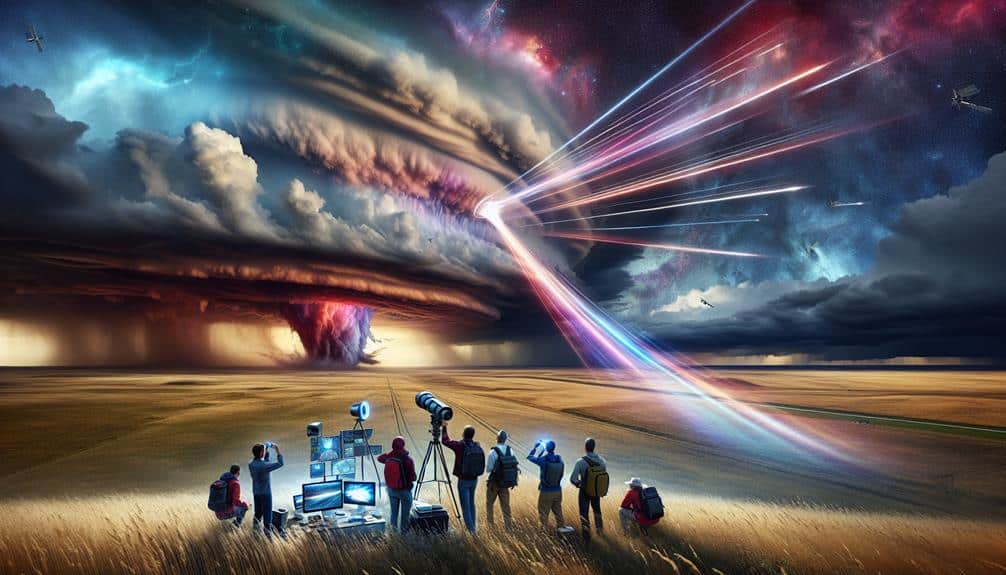
Ensuring the integrity and accuracy of data collected during supercell storm chases is vital for advancing meteorological research and public safety. We must prioritize robust data management practices to guarantee our findings are reliable and can be used effectively by the broader scientific community. By implementing systematic approaches to data collection, storage, and analysis, we can maintain the highest standards of precision and objectivity.
Ethical sharing of our data is a responsibility we can't overlook. We should always verify the accuracy of our data before dissemination, guaranteeing that it meets rigorous scientific standards. Misleading or inaccurate data can compromise research outcomes and public safety measures. Hence, it's essential to adopt transparent methodologies, openly sharing our data sources, collection methods, and any potential limitations.
Responsible data sharing also involves respecting privacy and intellectual property rights. When collaborating with other researchers or institutions, we must ensure that data is shared within agreed-upon frameworks that protect all parties' contributions. By fostering a culture of ethical sharing and rigorous data management, we not only contribute to the advancement of meteorological science but also uphold the trust placed in us by the public and our peers.
Maintaining Professional Conduct
Upholding professional conduct during supercell storm chases is essential for ensuring safety, fostering collaboration, and maintaining the credibility of our research. We must adhere to ethical conduct guidelines to achieve these goals. Professional behavior isn't just about following rules; it's about setting a standard that others can trust and respect.
1. Safety Protocols:
Always prioritize the safety of yourself, your team, and the public. Utilize data-driven decision-making to navigate storm conditions.
2. Communication:
Maintain clear and consistent communication with fellow chasers and local authorities. This guarantees that everyone is informed and can act swiftly if conditions change.
3. Data Integrity:
Accurately record and report observations. Misleading or falsified data not only undermines our research but can also lead to dangerous consequences.
We should be conscious of our actions and their impact on the broader community. Ethical conduct requires that we respect property boundaries and local regulations. Let's remember, our goal is to gather valuable data without compromising our professional integrity.
Educating the Public
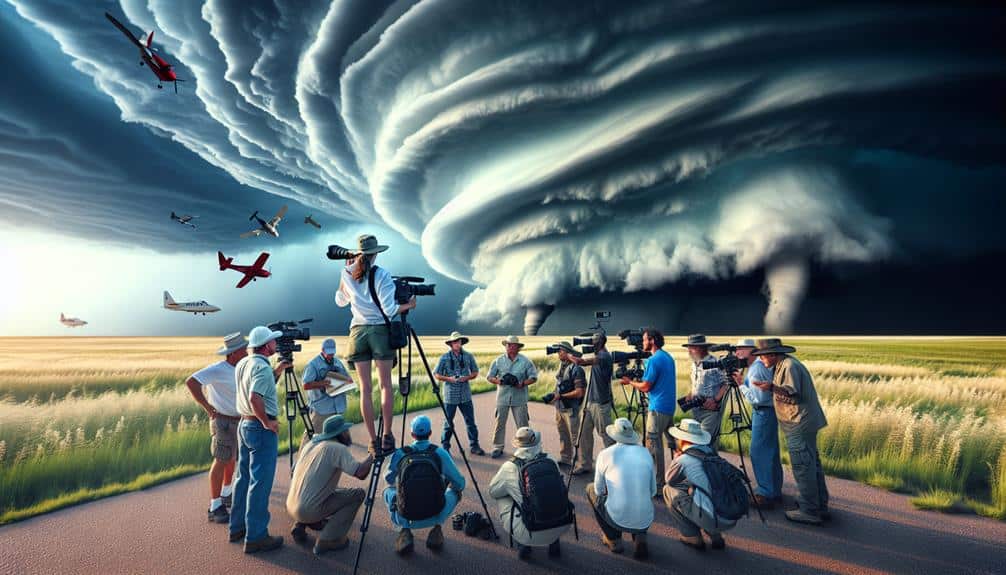
Educating the public about supercell storms requires clear, data-driven communication to enhance understanding and promote safety awareness. We must convey complex meteorological concepts in an accessible manner, using precise terminology and visual aids. Our goal is to elevate public awareness, helping communities grasp the dynamics of supercell storms, their potential impacts, and the necessary precautions.
Community education involves disseminating scientifically accurate information via multiple platforms, including social media, workshops, and public forums. We should leverage real-time data and historical case studies to illustrate the behavior and risks associated with these storms. By doing so, we empower individuals to make informed decisions when confronted with severe weather.
Our social responsibility extends beyond mere information sharing; it includes ethical considerations like ensuring that our communications don't incite unnecessary fear or complacency. We must balance urgency with accuracy, providing clear action steps for public safety without sensationalism. By prioritizing ethical guidelines, we uphold the trust of the communities we serve.
Ultimately, fostering an educated public leads to better-prepared communities. Through diligent community education and a steadfast commitment to social responsibility, we can enhance public awareness and contribute to a safer, more informed society.
Frequently Asked Questions
What Types of Equipment Are Essential for Storm Chasing?
Storm chasing is like maneuvering a high-stakes chess game. We need essential gear like weather radios, GPS, and sturdy vehicles. Safety precautions include helmets, first aid kits, and communication devices to guarantee our freedom to explore safely.
How Can I Become a Certified Storm Chaser?
To become certified storm chasers, we must complete a certification process that includes extensive training programs. These programs cover meteorology, safety protocols, and data collection techniques, ensuring we're well-prepared to chase storms safely and effectively.
What Are the Best Apps for Tracking Supercell Storms?
We'd need the best tracking apps to chase storms like we're hunting giants: RadarScope for precision, Storm Shield for emergency alerts, and MyRadar for real-time updates. These guarantee safety precautions and enhance storm photography and storm spotting.
How Do I Interpret Radar Data Effectively?
To interpret radar data effectively, we focus on radar analysis, identifying storm structures like hooks or inflows. Prioritize storm safety by monitoring velocity data for rotation, ensuring we stay informed and make independent, accurate decisions.
What Should I Pack for a Storm Chasing Trip?
For a storm chasing trip, we should pack emergency supplies, including first aid kits and non-perishable food. Bringing communication devices like two-way radios and satellite phones guarantees we stay connected. Proper gear guarantees safety and efficiency.
